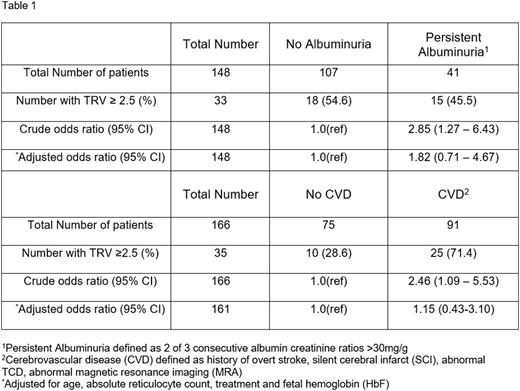Abstract
Introduction: Adult patients with sickle cell disease (SCD) develop progressive end-organ injury leading to multi-organ disease and increased mortality. It is plausible that this multi-organ damage begins in pediatric patients. Tricuspid regurgitation velocity (TRV), measured by echocardiography is a surrogate marker for pulmonary hypertension that is a poor prognostic factor in adults with SCD. The utility of screening echocardiograms as a marker of disease severity is being studied in pediatrics. In this study, we assessed associations between elevated TRV with early development of chronic kidney disease (albuminuria), and cerebrovascular disease (CVD).
Methods: We performed an IRB approved cross-sectional study to evaluate the prevalence of elevated TRV ≥ 2.5 m/s and its associations with albuminuria and CVD in patients with SCD ages 1-21 years. We included children with a diagnosis of SCD who had at least one echocardiogram performed during an outpatient clinic visit at steady-state for screening for pulmonary hypertension. We categorized patients as receiving either transfusion therapy (chronic transfusion for >12 months), SCD modifying therapy (hydroxyurea, voxelotor, crizanlizumab, or L-glutamine), or no therapy. Patients on both transfusion and a SCD modifying therapy were defined as being on transfusion therapy. We defined albuminuria as patients with two of three consecutive albumin creatinine ratios ≥30mg/g measured during standard clinic visits. Cerebrovascular disease was defined as having either 1) an overt stroke, 2) silent cerebral stroke defined by MRI, 3) vasculopathy by abnormal magnetic resonance angiography (MRA), 4) transient ischemic event defined by stroke symptoms that resolved within 24 hours, or 5) abnormal TCD (>200 cm/second).
We performed bivariate analysis utilizing t-test (or Kruskal-Wallis test) and Cochran-Mantel-Haenszel test for continuous and categorical variables respectively. To determine the association between elevated TRV and albuminuria, and elevated TRV and CVD, logistic regression was fit and adjusted for variables that were significant in the bivariate analysis. Using the TRV <2.5m/sec as the reference group, adjusted odds ratios with their accompanying confidence intervals were calculated for those with albuminuria and those with CVD in separate models. All reported P values were 2-sided. Statistical significance was defined as p<0.05. All analyses were performed using Statistical Analysis Software 9.4, (SAS Institute, Cary, NC).
Results: Among 166 children with echocardiography, the prevalence of an elevated TRV was 21%. On bivariate analysis, elevated TRV was significantly associated with persistent albuminuria (OR 2.85 (95% CI: 1.27-6.43) and cerebrovascular disease (OR: 2.46 (95% CI: 1.09-5.53) (Table 1). An elevated TRV was also significantly associated with increased age (15.6 vs 12.9 yrs, p=0.005), lower hemoglobin F% (2.5 vs 4.6%, p=0.01), higher absolute reticulocyte count (0.5 vs 0.4 x 106/ µL p=0.005) and chronic transfusion therapy (p=0.04). After adjusting for age, absolute reticulocyte count, HbF and treatment in a multivariable logistic regression, the associations between elevated TRV with either persistent albuminuria (OR: 1.82 (0.71 - 4.67)) and cerebrovascular disease (OR: 1.15 (0.43-3.10)) were no longer statistically significant (Table 1). Our data suggests that with an odds ratio of 2.9 and a prevalence of elevated TRV of 20%, a prospective study of 166 adolescent patients with SCD would be needed to detect the association between elevated TRV and persistent albuminuria with 80% power and 233 children would be needed to detect this difference with 90% power.
Conclusion: This data provides additional evidence that around 20% of pediatric patients have an elevated TRV and those patients may also have an increased risk for developing chronic kidney disease and cerebrovascular disease. A larger, prospective cohort study should be conducted to confirm these findings and determine the role of screening echocardiography in pediatric SCD. At minimum, our data suggests that pediatric patients with known chronic kidney disease or cerebrovascular disease should be screened for cardiac complications. Furthermore, longitudinal studies are needed to evaluate the association between elevated TRV in children with early end-organ complications in adults.
Disclosures
Ilonze:Global Blood Therapeutics: Consultancy. Lebensburger:BPL: Consultancy; Novartis: Consultancy; Forma Therapeutics: Consultancy; Agios Pharmaceuticals: Consultancy.
Author notes
Asterisk with author names denotes non-ASH members.


This feature is available to Subscribers Only
Sign In or Create an Account Close Modal